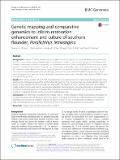Files in this item
Genetic mapping and comparative genomics to inform restoration enhancement and culture of southern flounder, Paralichthys lethostigma
Item metadata
| dc.contributor.author | O’Leary, Shannon J. | |
| dc.contributor.author | Hollenbeck, Christopher M. | |
| dc.contributor.author | Vega, Robert R. | |
| dc.contributor.author | Gold, John R. | |
| dc.contributor.author | Portnoy, David S. | |
| dc.date.accessioned | 2018-04-12T14:30:53Z | |
| dc.date.available | 2018-04-12T14:30:53Z | |
| dc.date.issued | 2018-02-23 | |
| dc.identifier | 252804751 | |
| dc.identifier | c554cbe7-20a5-4a6a-b252-e1da90520de7 | |
| dc.identifier | 85042405357 | |
| dc.identifier | 000426306300003 | |
| dc.identifier.citation | O’Leary , S J , Hollenbeck , C M , Vega , R R , Gold , J R & Portnoy , D S 2018 , ' Genetic mapping and comparative genomics to inform restoration enhancement and culture of southern flounder, Paralichthys lethostigma ' , BMC Genomics , vol. 19 , 163 . https://doi.org/10.1186/s12864-018-4541-0 | en |
| dc.identifier.issn | 1471-2164 | |
| dc.identifier.other | RIS: urn:4F760A937B7A6772C557A384BD423FA3 | |
| dc.identifier.uri | https://hdl.handle.net/10023/13126 | |
| dc.description | Funds were provided by Texas Parks and Wildlife and the U.S. Fish and Wildlife Service through a Wildlife & Sport Fish Restoration State Wildlife Grant (TX T-112). | en |
| dc.description.abstract | Background: Southern flounder, Paralichthys lethostigma, historically support a substantial fishery along the Atlantic and Gulf coasts of the southern United States. Low year-class strengths over the past few years in the western Gulf of Mexico have raised concern that spawning stocks may be overfished. Current management of the resource includes releasing hatchery-raised juveniles to restock bays and estuaries; additionally, there is a growing interest in the potential for commercial aquaculture of the species. Currently, genomic resources for southern flounder do not exist. Here, we used two hatchery-reared families and double-digest, restriction-site-associated DNA (ddRAD) sequencing to create a reduced-representation genomic library consisting of several thousand single nucleotide polymorphisms (SNPs) located throughout the genome. Results: The relative position of each SNP-containing locus was determined to create a high-density genetic map spanning the 24 linkage groups of the southern flounder genome. The consensus map was used to identify regions of shared synteny between southern flounder and seven other fish species for which genome assemblies are available. Finally, syntenic blocks were used to localize genes identified from transcripts in European flounder as potentially being involved in ecotoxicological and osmoregulatory responses, as well as QTLs associated with growth and disease resistance in Japanese flounder, on the southern flounder linkage map. Conclusions: The information provided by the linkage map will enrich restoration efforts by providing a foundation for interpreting spatial genetic variation within the species, ultimately furthering an understanding of the adaptive potential and resilience of southern flounder to future changes in local environmental conditions. Further, the map will facilitate the use of genetic markers to enhance restoration and commercial aquaculture. | |
| dc.format.extent | 11 | |
| dc.format.extent | 4011078 | |
| dc.language.iso | eng | |
| dc.relation.ispartof | BMC Genomics | en |
| dc.subject | Linkage map | en |
| dc.subject | RADseq | en |
| dc.subject | Aquaculture | en |
| dc.subject | Synteny | en |
| dc.subject | QH301 Biology | en |
| dc.subject | QH426 Genetics | en |
| dc.subject | SH Aquaculture. Fisheries. Angling | en |
| dc.subject | DAS | en |
| dc.subject | SDG 14 - Life Below Water | en |
| dc.subject.lcc | QH301 | en |
| dc.subject.lcc | QH426 | en |
| dc.subject.lcc | SH | en |
| dc.title | Genetic mapping and comparative genomics to inform restoration enhancement and culture of southern flounder, Paralichthys lethostigma | en |
| dc.type | Journal article | en |
| dc.contributor.institution | University of St Andrews. School of Biology | en |
| dc.identifier.doi | 10.1186/s12864-018-4541-0 | |
| dc.description.status | Peer reviewed | en |
This item appears in the following Collection(s)
Items in the St Andrews Research Repository are protected by copyright, with all rights reserved, unless otherwise indicated.

